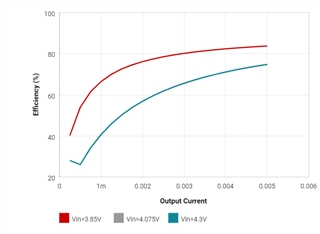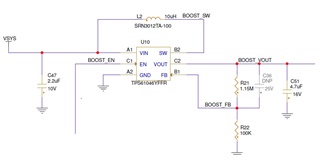Hi,
I am writing to request your assistance in improving the efficiency of a boost converter circuit in our design.
We are currently using the TI TPS61046YFFR to convert a LiPo battery voltage (3.0V to 4.35V) to 10V for powering the OLED display.
Typical load current: 5.5mA at 10V output
Measured efficiency:
67% at 4.22V input voltage
68.5% at 3.85V input voltage
The measured efficiency is lower than in the WEBENCH Power Designer simulation with similar components.
Simulated efficiency:
75% at 4.3V input
83% at 3.85V input

my design

I have limited PCB size and height restrictions for the boost circuit and the output voltage noise below 50mV (critical for noiseless OLED display).
Bill of Materials (BOM):
IC: Texas Instruments TPS61046YFFR
Inductor: Bourns SRN3012TA-100M (10uH, DCR=0.245ohm, Isat=0.76A)
Input Capacitor: Murata GRM033R61A225KE47D (2.2uF, 10V, X5R, 0201)
Output Capacitor: Samsung CL05A475MO5NUN (4.7uF, 16V, X5R, 0402)
We would greatly appreciate your expertise in identifying potential areas for improvement in our boost converter design to achieve the simulation efficiency levels while adhering to the size, height, and noise constraints.
Thank you for your time and support.

